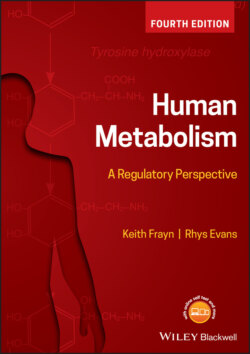Читать книгу Human Metabolism - Keith N. Frayn - Страница 24
1.3 General overview of metabolism 1.3.1 Human metabolic pathways
ОглавлениеThe body requires energy for chemical and mechanical work in order to maintain homeostasis; functions include maintenance of ionic gradients, transport, biosynthesis, heat generation and muscle contraction. Metabolism describes the series of biochemical reactions which provide the body with the energy it requires to maintain these biological functions. This energy must ultimately be derived from food, and is sourced from three groups of energy-rich substrates: carbohydrates, lipids, and amino acids (proteins). Multiple groups are utilised because they all have chemical and thermodynamic advantages and disadvantages, and together they provide energy under widely varying conditions and demands. All three nutrient groups exist in large, energy-rich macromolecular storage forms, discussed further in Chapter 7; they are all related to daily fluxes of energy substrates in the body.
For energy mobilisation these are sequentially broken down into less energy-rich metabolites, the energy liberated being captured by intermediary reduction-oxidation molecules which carry the energy to a common pathway of oxidation linked to the phosphorylation of ADP to ATP. Hence, the energy is used to synthesise ATP, the common energy carrier to which most energy- requiring biological processes are linked. At a whole-body level this process is termed ‘catabolism’ (from the Greek: κατα (kato) – ‘down’ and βαλλω (ballo) – ‘throw’). Conversely, in energy-rich states when energy intake exceeds expenditure, these metabolic pathways can be reversed, whereby ingested nutrients from all three groups are assembled into large storage macromolecules (‘anabolism’; again, from the Greek: ανα [ana] – ‘up’). The process of assembling excess energy-rich substrate precursors into complex energy storage molecules is termed anabolism, whilst processes converting substrates into energy-poor end-products to mobilise biologically usable energy, are termed catabolism (Figure 1.12 and Box 1.4). Imbalance of these pathways leads to cachexia (wasting) or obesity, with implications for both energy provision and health. Tissues have specialised metabolic functions – e.g. adipose tissue stores energy, muscle oxidises substrate, lactating mammary gland exports substrate. The liver is a metabolic ‘transformer’ that regulates substrate supply between tissues, and pancreas is the principal afferent detector, and signaller, of nutritional status.
Figure 1.12 Catabolism and anabolism.
